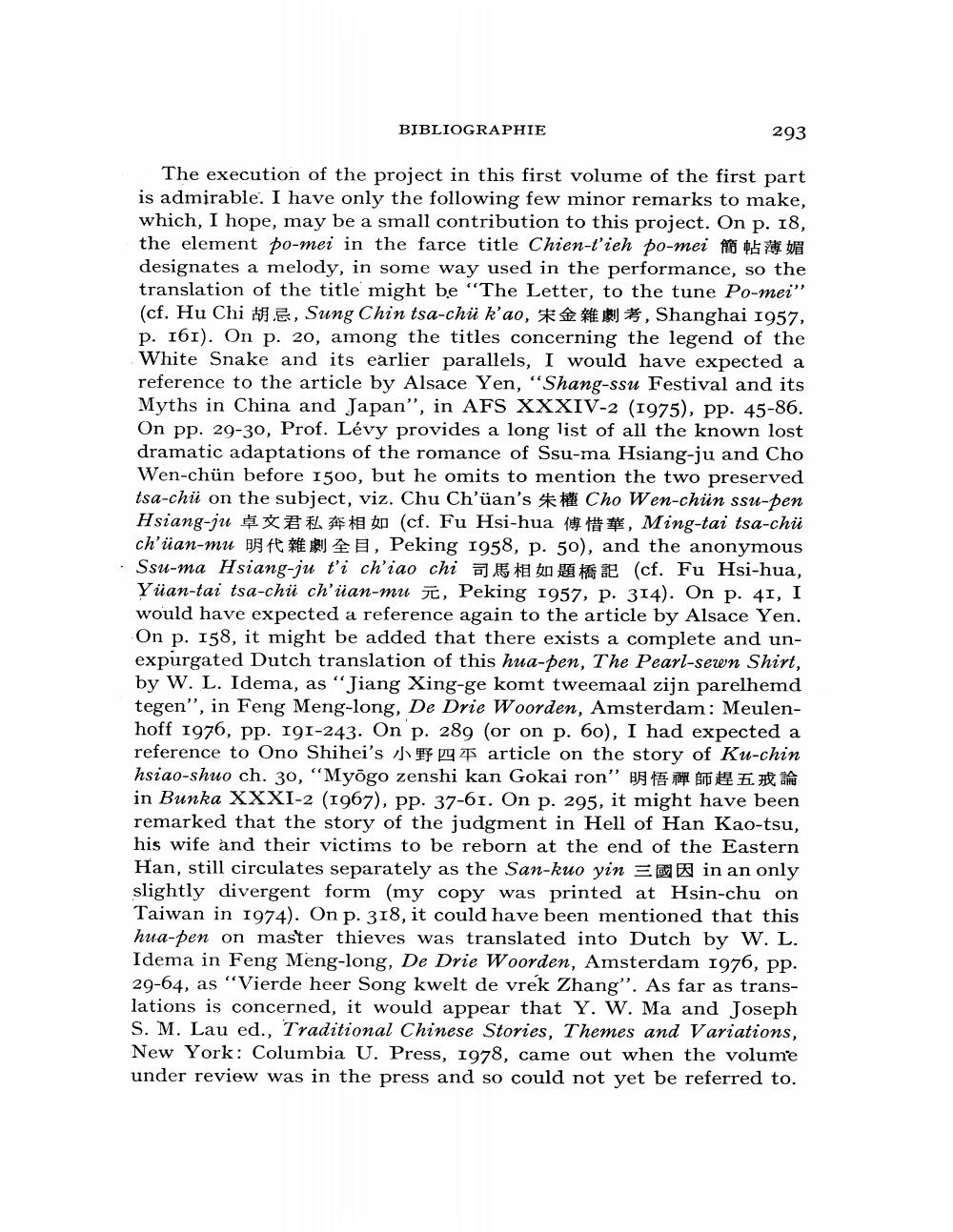________________
BIBLIOGRAPHIE
293
The execution of the project in this first volume of the first part is admirable. I have only the following few minor remarks to make, which, I hope, may be a small contribution to this project. On p. 18, the element po-mei in the farce title Chien-t'ieh po-mei o d i designates a melody, in some way used in the performance, so the translation of the title might be "The Letter, to the tune Po-mei" (cf. Hu Chi JE, Sung Chin tsa-chü k'ao, *4 *, Shanghai 1957, p. 161). On p. 20, among the titles concerning the legend of the White Snake and its earlier parallels, I would have expected a reference to the article by Alsace Yen, “Shang-ssu Festival and its Myths in China and Japan”, in AFS XXXIV-2 (1975), pp. 45-86. On pp. 29-30, Prof. Lévy provides a long list of all the known lost dramatic adaptations of the romance of Ssu-ma Hsiang-ju and Cho Wen-chün before 1500, but he omits to mention the two preserved tsa-chü on the subject, viz. Chu Ch'uan's ## Cho Wen-chün ssu-pen Hsiang-ju * 4 * tn (cf. Fu Hsi-hua , Ming-tai tsa-chü ch'üan-mu o te
, Peking 1958, p. 50), and the anonymous Ssu-ma Hsiang-ju t'i ch'iao chi a Elit e (cf. Fu Hsi-hua, Yüan-tai tsa-chü ch'üan-mu , Peking 1957, p. 314). On p. 41, I would have expected a reference again to the article by Alsace Yen. On p. 158, it might be added that there exists a complete and unexpurgated Dutch translation of this hua-pen, The Pearl-sewn Shirt, by W. L. Idema, as “Jiang Xing-ge komt tweemaal zijn parelhemd tegen", in Feng Meng-long, De Drie Woorden, Amsterdam: Meulenhoff 1976, pp. 191-243. On p. 289 (or on p. 60), I had expected a reference to Ono Shihei's l pg article on the story of Ku-chin hsiao-shuo ch. 30, "Myōgo zenshi kan Gokai ron" BETE TE FT. ARIA in Bunka XXXI-2 (1967), pp. 37-61. On p. 295, it might have been remarked that the story of the judgment in Hell of Han Kao-tsu, his wife and their victims to be reborn at the end of the Eastern Han, still circulates separately as the San-kuo yin E i n an only slightly divergent form (my copy was printed at Hsin-chu on Taiwan in 1974). On p. 318, it could have been mentioned that this hua-pen on master thieves was translated into Dutch by W. L. Idema in Feng Meng-long, De Drie Woorden, Amsterdam 1976, pp. 29-64, as "Vierde heer Song kwelt de vrek Zhang". As far as translations is concerned, it would appear that Y. W. Ma and Joseph S. M. Lau ed., Traditional Chinese Stories, Themes and Variations, New York: Columbia U. Press, 1978, came out when the volume under review was in the press and so could not yet be referred to.




